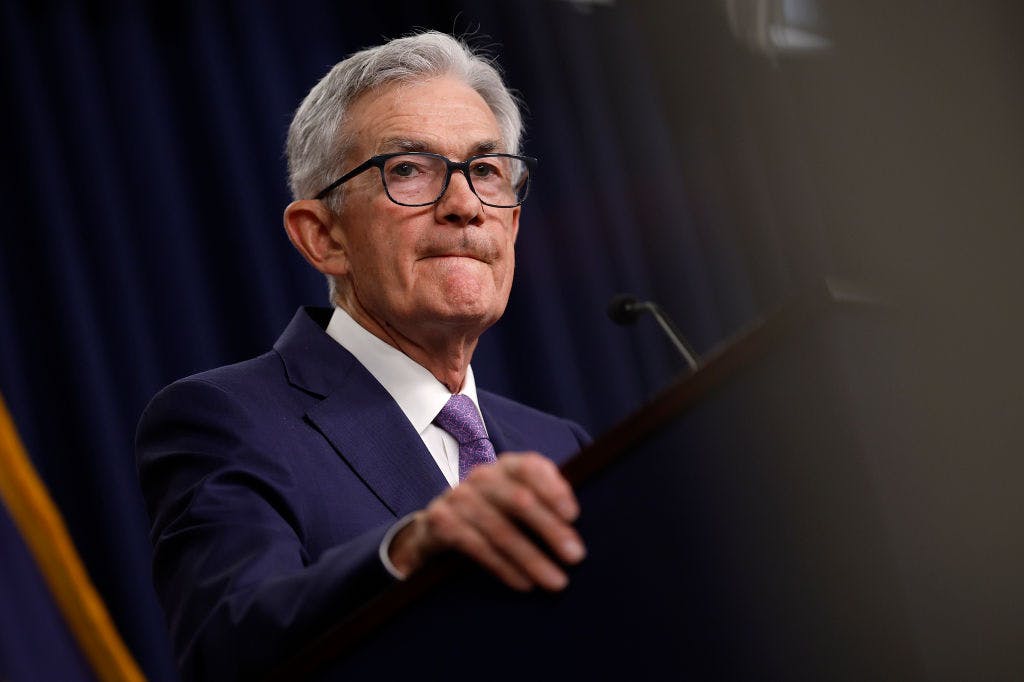The Fed’s creeping concern about surging US stocks
The central bank does not want to be the key cog in your bull case.
The Federal Reserve kept its policy rate unchanged at a range of 5.25-5.5% in its Wednesday decision, while acknowledging that recent inflation data is a step in the right direction.
The central bank now anticipates the policy rate will go down only 25 basis points between now and year-end, compared to the 75 basis points worth of cuts seen in March. But most Fed officials didn’t revise their forecasts following this morning’s surprisingly soft CPI inflation data, according to Chair Jerome Powell.
US Treasuries pared about half their post-CPI gains, while stocks held on to most of them for another record closing high.
Here are the big takeaways from Wednesday’s updated economic projections and press conference.
Wait and see
Back in January, Powell effectively took a March rate cut off the table by saying it was unlikely that the Federal Reserve would gain sufficient confidence that inflation would trend sustainably towards its target by then. When asked today whether the “modest further progress” the central bank had seen recently on inflation would, if sustained, pave the way for a rate cut in September, he didn’t say yes. But! He didn’t say no, either.
The nothing’s changed economy
The Federal Reserve’s forecasts suggest that at year end, the annual rate of core PCE inflation and the unemployment rate will be exactly the same as they are now. And that would be sufficient to shift the Fed from sitting on its hands to starting to ease policy.
Another way of saying that is the Federal Reserve sees this set of economic conditions as well worth preserving. Even with inflation a little above target, and expected to stay so through 2025, preserving this mix of labor market and inflation outcomes more or less constitutes mission accomplished, in their eyes.
If these outcomes are indeed realized (a big if), that would seem to be very positive for risk assets, in a vacuum. Economic volatility going to zero for half a year is a positive, considering the backdrop we have has proved very conducive to driving profit growth for publicly-traded companies.
Good thing monetary policy is the end-all, be-all for markets, and there isn’t a big event happening in the US between now and year-end that could prompt a major re-evaluation of the outlook for fiscal policy and earnings growth going forward!
Animal spirits a worry
A sharp increase in the stock market, in theory, feeds through into stronger economic growth, which may in turn push inflationary pressures upwards. The Fed is cognizant (if not somewhat worried about) this potential sequence of events.
“When we do start to loosen policy, that will show up in a significant loosening in financial market conditions,” said Powell.
On the contrary: markets can price this in well of the Federal Reserve actually doing anything! Last year, the Fed put the tightening cycle to bed, which led market participants to price the next move from the central bank as a cut. The stock market’s rise during the four-month period from November through March was comparable to what normally happens when the US economy is on the verge of emerging from a recession (or some particularly explosive parts of the dot-com bubble).
The Fed wants rate cuts to stabilize an economy that’s cooling, not spark a mini-boom. Or, in other words, the Fed wants stocks to go up on sustaining earnings growth around this level, not an acceleration in profit growth or multiple expansion. The Federal Reserve does not want to be the key cog in your bull case for stocks.
Besides through the portfolio management subcomponent of inflation, it’s not too obvious that there are channels through which this surge in the stock market caused higher inflation outturns in 2024. What we heard today seems to be a tinge of concern from the Fed over how buoyant financial markets might impede its ability to accomplish its goals over time. This may influence the timing and amount of any rate cuts delivered in the future.
Bifurcation
Monetary policymakers at the Fed are split into two major camps:
There are seven officials who think that one 25 basis point rate cut would be appropriate this year if the economy evolves as they anticipate, and eight looking for 50 basis points of easing (and then four relative outliers expecting no change).
Policymakers are all basically looking for nearly the same data, give a tenth of a percentage point here or there: The ranges of forecasts for end-2024 inflation and the unemployment are narrower than in March (granted, one would expect this to compress as the year progresses).
During the press conference, Powell said that many officials saw it as a very close call between one versus two cuts. So either there are very fine margins on what data is needed to get one cut versus two, or officials are divided on how they’d react to exactly the same data. Probably a mix of both is at play here.
No big rethink
Inflation re-accelerated in Q1. Economic growth and job growth are solid. Corporate America’s putting up big numbers, and credit spreads are near historically tight levels. All of that has led people to wonder if US policy rates above 5% are really putting that much downward pressure on the economy and interest rates.
The Federal Reserve doesn’t appear to have changed its thoughts on what constitutes restrictive policy.
If you deflate the Federal Reserve’s dot plot of projected policy rates by their corresponding core PCE inflation forecasts to arrive at the inflation-adjusted or “real” policy rate, the numbers are pretty much the same as they were in March. Inflation has run a little hotter than expected, so rates will stay a little higher for longer. There’s no dramatic rethink of what the Fed thinks it needs to do to attain its dual mandate of price stability and full employment.
